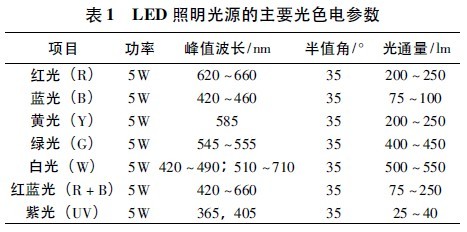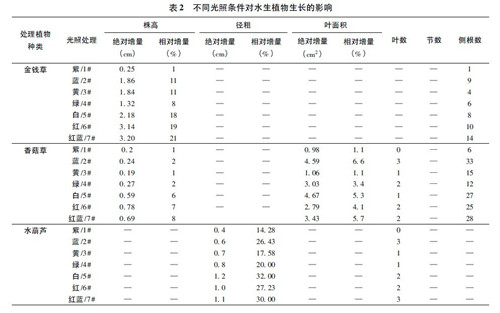In recent years, China's leisure and ornamental fisheries have developed strongly, and have become a new bright spot in the development of fisheries. Ornamental fish are “walking†into ordinary families. The main characters of the eco-aquarium are fish and aquatic plants, and visual appreciation is its main function. The lighting system of the aquarium plays a decisive role. LED is considered to be the main and ideal artificial water and plant light source in the future. It has the advantages of high brightness, narrow band, energy saving, environmental protection and long life. Therefore, the experimental research on the influence of monochromatic LED on aquatic animals and plants was carried out, and the application principle and key technical parameters of LED in aquarium lighting were obtained.
1 Experimental part
1. 1 Materials and instruments
Aquatic plants (Lianhua, water hyacinth, mushroom grass, blue silk, tiger ear and red butterfly), aquatic animals (tiger fish, red swordfish, black horse), algae; samples taken from Hebei University and fish market . The experimental lighting conditions are provided by the high-power LED light source developed by this subject.
LED (5W red, blue, white, green, yellow, purple, red and blue); beaker, petri dish, thermometer; homemade water tank, fish tank; microcomputer time controller; etc.; main instrument has PMS-50 spectrum analysis system, LED626 distribution Photometer, TES-1332A illuminometer, electronic balance, NJ2-1 upright metallographic microscope.
1. 2 Experimental methods
1. 2. 1 Effect of monochromatic LED illumination on aquatic plant growth
The test set red, white, green, yellow, blue, red, blue and violet light conditions, the spectral characteristics of each light source are shown in Table 1.

The seedlings of similar aquatic plants with similar growths were divided into 7 groups, each group consisting of 4 species (Lianhua, water hyacinth, blue silk, and mushroom), each of which was distributed in 21 beakers (beakers The same amount of distilled water of the same quality was added; 7 test groups were respectively treated with light conditions of R, B, Y, G, W, R + B, and UV under the design of the study, without natural light, each light source The light source suspension height is 10cm, and the illumination period is set by the microcomputer timing device. The time is: 6: 00~8: 00; 10: 00~12: 00; 14: 00~16: 00; 18: 00 to 20: 00.
Observed indicators: Determination of leaf area, plant height, number of new leaves and number of lateral roots of Lentinula edodes; determination of the number of lateral roots and height of plants, and statistical analysis of absolute growth and relative growth of plant height; Number of knots and number of lateral roots; Determination of stem diameter, leaf area and number of new leaves of water hyacinth.
1. 2. 2 Comparison of LED combined light source and aquatic plant growth under fluorescent light
The aquatic plants, the tiger ear and the red butterfly, were divided into two experimental groups, each of which was inserted into two water tanks; the light treatment was carried out with “R + B†light source and plant fluorescent lamp, respectively, and the treatment was the same as (1); Plant height per plant, number of leaves, number of lateral buds, and number of lateral roots were recorded weekly.
1. 2. 3 The effect of monochromatic LED illumination on fish growth
The test set up 6 test groups, each of which is a group, each set of 10 tiger skins, red arrows, black Mary, and 1 scavenger fish. The water quality of each group is the same, the aeration pump increases oxygen throughout the day, and regularly changes water and disinfects the drug. 0 0. 05 g each time. The illumination treatment methods of the six test groups are the same as (1) (no R + B mode).
The light adaptation condition of the fish was observed at 1 min, 5 min, 10 min, 20 min, 1 h, 2 h, 4 h after the start of the experiment. The length of the fish and the weight of the fish were measured by self-made methods at the beginning, 20 days and 40 days after the test. , classification statistics, record the average growth of fish length and the absolute and relative increase in fish weight gain; observe the changes in water quality, fish body color change, growth status, survivability at any time, will be dead fish in each observation The supplement is given in time according to its same kind and considerable weight.
1. 2. 4 Effect of monochromatic LED illumination on the growth rate of green Dunaliella
The test green Dunaliella was provided by the College of Life Sciences of Hebei University. The conical flask is sterilized by boiling. The algae solution was taken in a 250 mL Erlenmeyer flask, and then the BBM culture solution was added. The volume ratio of the algae solution to the culture solution was 1:3, and then cultured under the set test conditions, and the flask was shaken several times a day.
Five experimental groups were set up and placed under the R, B, Y, G, and W light sources of this study. Each group was set up with 3 replicates, and the photoperiod was 12L: 12D. After 3 days of culture, it was taken out and its growth was measured. rate.
1. 2. 5 Effects of ultraviolet light on algae habitat
Take a certain amount of algae, place it in a Petri dish, add BBM medium, and after 1 day, observe the species of algae by microscope; shake up the culture medium and take 3 ml of the algae cell suspension in 7 small Petri dishes. Then, the culture dish was placed at 20 cm from a UV light source with a power of 15 W, and irradiated for 0 s, 3 min, 5 min, 7 min, 10 min, 13 min, 15 min, 17 min, 20 min, respectively. The algae changes were observed with a microscope.
2 Results and analysis
2. 1 Effect of monochromatic LED illumination on aquatic plant growth
The results of the effects of monochromatic high-power LED illumination on plant height, leaf area, leaf number, number of nodes and lateral root growth of aquatic plants such as Lysimachia chinensis, Lentinula edodes, green silk red leaves and water hyacinth are shown in Table 2.

The experiment shows that there are significant differences in the growth of four aquatic plants grown under different illumination, but the trend of light response is basically the same. Irradiated by red and white light, the plant height of Lysimachia chinensis and green leaves is relatively large, while the relative growth of the plant height of Lysimachia chinensis is small by the irradiation of purple and yellow light, and the leaf diameter of the water hyacinth and the leaf area of ​​the mushroom grass are also expressed. The same result; Blu-ray treatment of Lentinula edulis grows the most new leaves, while the purple light is the least; blue, red light treatment of Lysimachia, blue silk leaves and mushroom grass roots grow more, and purple light is less.
In general, leaves are the most important organ for photosynthesis in plants, and the size of the leaf area determines the rate of plant photosynthesis. Red light can accelerate the rate of photosynthesis, enhance the anabolism of chlorophyll and other cell contents, and accelerate cell division. This photosynthetic regulation mechanism has a certain relationship with the growth rate of water plants under red light. In addition, the absorption of blue light and red light by chlorophyll is stronger than that of other light waves. The absorption of red light from 640 to 660 nm by chlorophyll a is 1.5 times that of blue light of 430 to 450 nm, and the absorption of blue light by chlorophyll b is red light. Times, the ratio of the two chlorophyll constitutes different utilization of light energy, and the two chlorophylls play complementary roles in the absorption of red and blue light. The green water grass is suitable for red and blue light, while the red water grass is mainly composed of blue and green spectrum of “near ultraviolet lightâ€.
